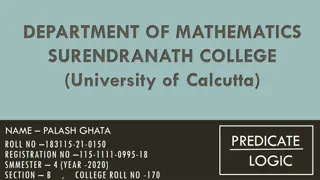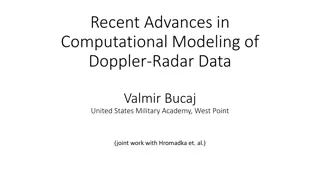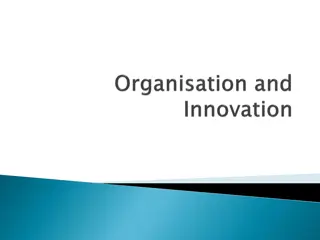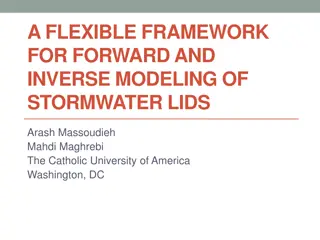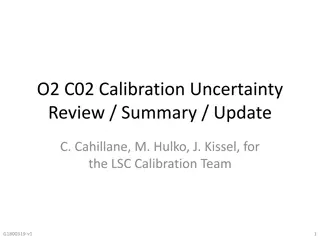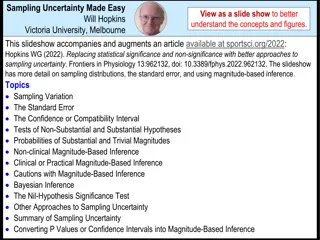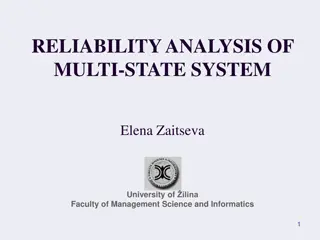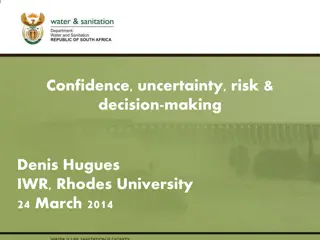
Advanced Techniques in Uncertainty Quantification and Analytical Modeling
Explore cutting-edge techniques in Uncertainty Quantification (UQ) and Analytical Modeling (AM) for quantitative assessment of uncertainties, generation of response surfaces, leveraging PSUADE and Dakota toolkits, MARS algorithm, and resource allocation choices in a global computing environment.
Download Presentation

Please find below an Image/Link to download the presentation.
The content on the website is provided AS IS for your information and personal use only. It may not be sold, licensed, or shared on other websites without obtaining consent from the author. If you encounter any issues during the download, it is possible that the publisher has removed the file from their server.
You are allowed to download the files provided on this website for personal or commercial use, subject to the condition that they are used lawfully. All files are the property of their respective owners.
The content on the website is provided AS IS for your information and personal use only. It may not be sold, licensed, or shared on other websites without obtaining consent from the author.
E N D
Presentation Transcript
Task R&D Area 1.1 1.2 1.3 1.4 1.5 1.6 1.7 1.8 1.9 1.10 1.11 1.12 1.13 1.14 1.15 2.1 2.2 2.3 2.4 2.5 2.6 2.7 2.8 Data Management User Interface and Search Hardware & Network Data Transfer Installation (Containerized) Authentication & Authorization Federation Quality Control & Assurance Replication Distributed Search Metrics User Notification Long-tail Publication Distributed Computation Data Citation Provenance Capture Workflow Dynamic Resources In situ Analysis Machine Learning UQ Analytical Modeling Mobile Apps Uncertainty Quantification and Analytical Modeling James McEnerney, Ph.D. Lawrence Livermore National Laboratory Current capability status: Usable Prototype Research activity 2017 Triennial Project Review, Potomac, MD June 8 9, 2017
Uncertainty Quantification (UQ) Science of quantitative characterization and assessment of uncertainties in applications Tools for greater emphasis to understand simulation error Compute error bars from climate simulations Assess most sensitive model parameters Ensemble calculation with low resolution Derive response surfaces as an estimator 2
UQ techniques and methodologies Leverage PSUADE (LLNL) and/or Dakota (SNL) Toolkits supported by NNSA Response surface or surrogate model generation methods Purpose: use these functions instead of the application for output estimate Requirement: run the application many times for training data Principle techniques Multivariate Adaptive Regression Splines (MARS) Alternate response surfaces based on other generators Kriging, Radial basis functions, and others 3
MARS algorithm Created by Jerome Friedman from Stanford University late 80s-early 90s Algorithm fits a continuous function from an arbitrary training data set Takes advantage of a specific generator for performance Serves as an estimator for application output instead running simulation Python interface to MARS is available in the 4
Analytical Modeling (AM) How much time is needed to perform computations in the workflow? Will it take 5 minutesor 5 weeksto access ESGF data? Goal: determine best recommendation! Required for global computing environment many choices of resource allocation 5
Integrated data ecosystem Data Collection and Management Sensors, field and lab experiments Data models Transport and communications Data quality and uncertainty Storage, provenance and discovery Provenance Capture Security Enabling integrated research Data Center and interoperable services Virtual Laboratory infrastructure Critical Complex Data Generation Systems Data Analytics (local & remote) Descriptive statistics Graph analytics Machine learning Signal and image processing Pattern discovery Visualization Exploratory analysis Data-Intensive Computing Architectures persistent data to streams Programming environments Human computer interface Decisions and Control Design Optimization Policy Making (Humans) Understanding and predicting use Analytical Modeling Network 6
Model the workflow ESGF Data requirements Virtual Laboratory performance data Resource allocation UQ response surface Performance archive Record timing data 7
Integration into ESGF Principle interface is through the Virtual Laboratory Analyze the ESGF data requirements Recommend resource allocation and utilization Display a table of resource configurations and performance projections Operation Modes Interactive and Automatic Record actual performance characteristics for subsequent analysis 8
Summary Uncertainty Quantification Improve understanding of application uncertainty What are the error bars? Leverage packages: PSUADE and DAKOTA Analytic Modelling Provide best timing estimate for end user of virtual laboratory How does a user distribute their computation efficiently? 9


